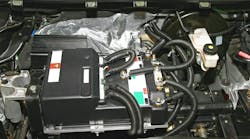3 Ways Silicon Carbide Paves the Path for Next-Gen EVs
What you’ll learn:
- What role does silicon carbide (SiC) play in enhancing the performance of electric vehicles?
- What are the long-term effects of widespread SiC adoption in the transportation industry?
Driven by increasing environmental awareness, regulatory incentives, and advances in technology, the electric-vehicle (EV) market is experiencing exponential growth, with some estimates predicting a 21% increase in passenger EV sales in 2024. Spurred in part by this EV boom, the market for silicon carbide (SiC), a transformative material in the technology and automotive industry, is projected to reach $11 billion to $14 billion in 2030.
SiC will be extensively used in renewables (solar, wind) and EV chargers, making a significant impact on the planet amidst the accelerating transition to EVs. For example, Soitec developed a SiC technology that reduces up to 40,000 tons of CO2 per 1 million wafers.
As the demand for cleaner and more sustainable transportation solutions continues to rise, the role of compound semiconductor materials such as SiC becomes more prominent. In fact, SiC is revolutionizing the future of EVs in three key ways: enhanced power electronics, increased efficiency and performance of vehicles, and enabling faster charging.
1. Enhanced Power Electronics
Power electronics forms the backbone of EVs, as it’s responsible for the control and conversion of electrical energy. The efficiency and reliability of these components are crucial for the overall performance of the vehicle.
In comparison to traditional silicon, SiC exhibits higher breakdown voltage, lower on-resistance, and superior thermal conductivity, resulting in reduced switching losses and higher operating temperatures. These properties translate to enhanced power-conversion efficiency and improved overall system performance, in tandem with reduced size, weight, and cost of vehicles.
EV performance is traditionally measured on mileage to be covered and the speed of charging time. In 2018, Tesla pioneered SiC as a key element in the AC-DC inverter in the powertrain to improve mileage and enable it to reach >500 km of autonomy. This autonomy is considered the minimum required for urban and highway use of EVs.
New entrants from China (BYD, Geely, etc.) and the U.S. (Tesla, Lucid, etc.) alongside historical brands (VW, Hyundai, BMW, Renault, Stellantis, Ford, GM, etc.) are all competing for more innovations and transformations. Their vehicles incorporate many SiC-based power electronics for enhanced efficiency and range.
2. Higher Power Efficiency and Performance
SiC plays a pivotal role in improving the efficiency and performance of EV drivetrains. Compared to traditional silicon-based components, SiC offers higher switching frequencies and lower losses, resulting in smoother operation and reduced energy consumption.
In addition to efficiency gains, SiC boosts vehicle performance within metrics such as acceleration and range. EVs equipped with SiC-based drivetrains deliver unparalleled driving experiences, offering consumers the advantages of both speed and sustainability.
Chipmakers and auto giants alike recognize the impact of SiC-based technologies, with governments subsidizing manufacturing projects, and chip manufacturers forging long-term partnerships to solidify future supply chains. An October 2023 report from McKinsey recounted that a dozen OEMs (representing more than 60% of 2030 BEV volume) have already announced multiple partnerships with SiC manufacturers, indicating that auto manufacturers are prioritizing SiC in their supply chains.
3. Fostering Fast Charging
With concerns about range anxiety and charging times being a significant barrier to adoption for consumers, fast charging infrastructure is critical for the automotive industry to enable EV growth. SiC technology is at the forefront of ushering in rapid charging solutions, revolutionizing the EV charging experience. SiC is also used in high-power chargers to shorten the charging time through the access to 800V bus voltage. Furthermore, it plays a significant role in setting the standard for charging rates.
SiC's high-voltage, high-power applications enable faster charging rates compared to traditional silicon-based systems. Low on-resistance in SiC also reduces power losses, increasing efficiency during charging compared to other materials like traditional silicon. On top of that, bidirectional charging, or vehicle-to-grid (V2G) technology, can transform EVs into mobile energy-storage units, contributing to grid stability and renewable-energy integration.
With SiC-based chargers, EV owners can replenish batteries significantly faster, making long-distance travel more realistic and convenient for the average consumer. The adoption of SiC will help transition EV charging to a process as quick and straightforward as a traditional gas station.
The Future of EVs and SiC
As we look to the future, the evolution of SiC technology alongside other compound semiconductors in EVs holds immense promise. Ongoing research and development efforts are focused on further improving SiC manufacturing processes, reducing costs, and enhancing performance.
SiC-based power modules continue to become more compact and lighter, allowing for greater design flexibility and integration. SiC technology is poised to play a pivotal role in accelerating the deployment of high-power charging infrastructure. With faster charging speeds and maximized energy efficiency, SiC-based chargers will set the standard for the EV charging networks of the future.
SiC’s contributions to enhanced power electronics, improved efficiency and performance, and fast charging will reshape the landscape of sustainable passenger transportation. The transformative potential of SiC extends beyond technological advances, with profound implications for the EV market and global consumer adoption.
As we look to the remainder of this year and beyond, SiC-based components will continue to become even more prevalent, with applications not only in passenger transportation, but also within renewable-energy systems, industrial drives, aerospace, railway, and data-center applications. The shift toward EVs represents massive technological, industrial, logistical, and commercial challenges, influencing road infrastructure and energy supply.
The scalability and versatility of SiC opens doors for a wide range of high-power and high-temperature applications across a number of industries. With SiC in our proverbial toolbox, the future of electric vehicles looks brighter than ever, leading to an era of cleaner, greener, and more efficient technological solutions.
Read more articles in the TechXchange: Silicon Carbide (SiC).


